The State of Web Accessibility in 2024 (Research Report)
As a leading accessibility scanning software provider and with help from BuiltWith.com, we analyzed over 63,000 websites and unpacked the advancements, shortcomings, and emerging trends in web accessibility practices.
We’ve paired the findings in this report with our in-depth expertise in the area of web accessibility to showcase the current state of web accessibility across the globe.
A Brief Overview:
- 88% of websites are still not fully compliant with the latest web accessibility standards.
- The average website only has an accessibility score of around 60/100.
- eCommerce websites only have an average accessibility score of around 64/100.
- Websites with an accessibility score of 75/100 or higher are shown to have higher levels of revenue.
Web Accessibility Assessment: Results Revealed
In our study, we categorized websites into three groups: Compliant (scoring 100 on our scanner), Partly Compliant (scoring above 85 on our scanner), and Not Compliant (scoring below 85 on our scanner).
Given that web accessibility is an ongoing effort, it’s essential to differentiate between websites actively addressing accessibility (Compliant and Partly Compliant) and those not doing so yet (Not Compliant).

Web Accessibility State: Dire Results
Out of the 63,000+ websites analyzed in this study, 88% were not compliant with the latest web accessibility standards. Just under 4% of all websites were fully compliant, indicating that multiple sectors are still creating online barriers for people with disabilities.
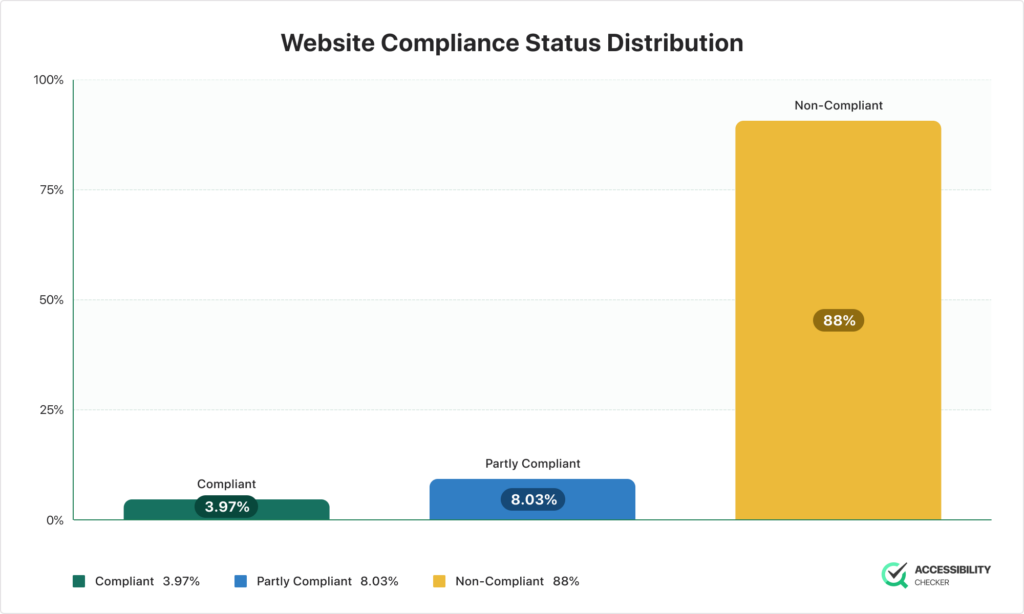
There are several reasons why this might be the case, including:
- Lack of Awareness: Many businesses may not be aware of ADA web accessibility standards and their importance, making it a lower priority for these organizations.
- The Complexity of Standards: The complexity of ADA web accessibility standards can pose challenges for those without web development or design backgrounds, making compliance more difficult.
- Cost and Resources: Achieving full compliance with ADA web accessibility standards can require significant resources, both in terms of time and money. Small businesses or organizations with limited budgets may find it challenging to allocate resources to make their websites fully accessible.
While many of these factors are relevant, website owners who fail to comply with the latest web accessibility standards could face costly penalties and brand damage. The cost of an accessibility lawsuit often far outweighs the time, money, and effort it takes to reach a compliant status, which is why web accessibility needs to be prioritized.
Average Accessibility Score by Country and Continent
Of the thousands of websites that we analyzed, it was found that the vast majority of compliant websites with accessibility scores of 90/100 or more are European-based, strongly followed by South America.
Great Britain, the United States, Ecuador, Spain, and Argentina were some of the countries that stood out from the rest. However, only a handful of countries had an acceptable accessibility score overall, so further compliance is required across most countries.
Breaking the scores down per continent, we can see that America, Europe, Oceania, and Africa have some of the higher average accessibility scores. North America showed an average score of 63/100, Europe 62/100, Oceania 63/100, and Africa 64/100.
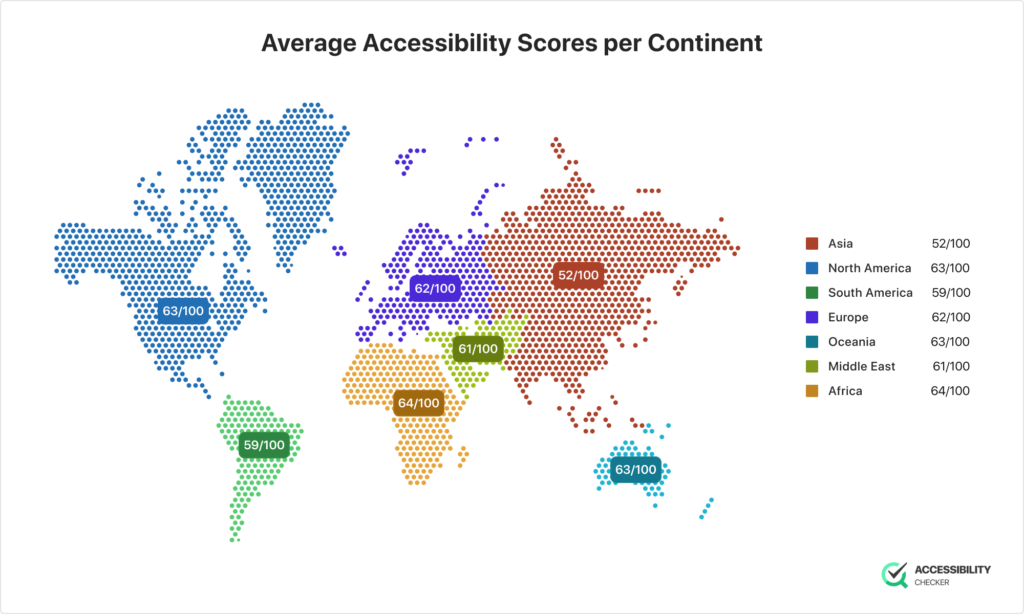
When we look at accessibility laws across the world, the United States and the European Union stand out in terms of awareness and the strict implementation of these standards, so it makes sense that the countries mentioned above have some of the better accessibility scores.
Further proof lies in the fact that Europe saw over 4,200 accessibility-related lawsuits in 2023 while the United States saw well over 8,000.
Compliance Status of eCommerce Websites
The COVID period has underscored the critical need for e-commerce websites to be accessible to everyone. Additionally, eCommerce sites are increasingly targeted in accessibility lawsuits.
However, a large percentage of online stores built using some of the most popular eCommerce platforms are not compliant with the necessary accessibility standards.
These sites are not only at risk of losing potential customers, but also being targets of costly accessibility lawsuits that would be far more financially detrimental than the cost of remediating their websites.
Out of the 895 e-commerce websites that we checked, only a small percentage were compliant per platform.
| eCommerce Platform | Compliant Websites | Partly-Compliant Websites | Non-Compliant Websites |
| Salesforce Commerce Cloud | 7% | 10% | 83% |
| SqaureSpace | 4% | 6% | 89% |
| Magento | 5% | 8% | 86% |
| BigCommerce | 8% | 7% | 85% |
| Webflow | 3% | 6% | 90% |
| Shopify | 11% | 14% | 75% |
| Drupal | 4% | 7% | 89% |
| Woocommerce | 0% | 11% | 89% |
| Weebly | 10% | 14% | 76% |
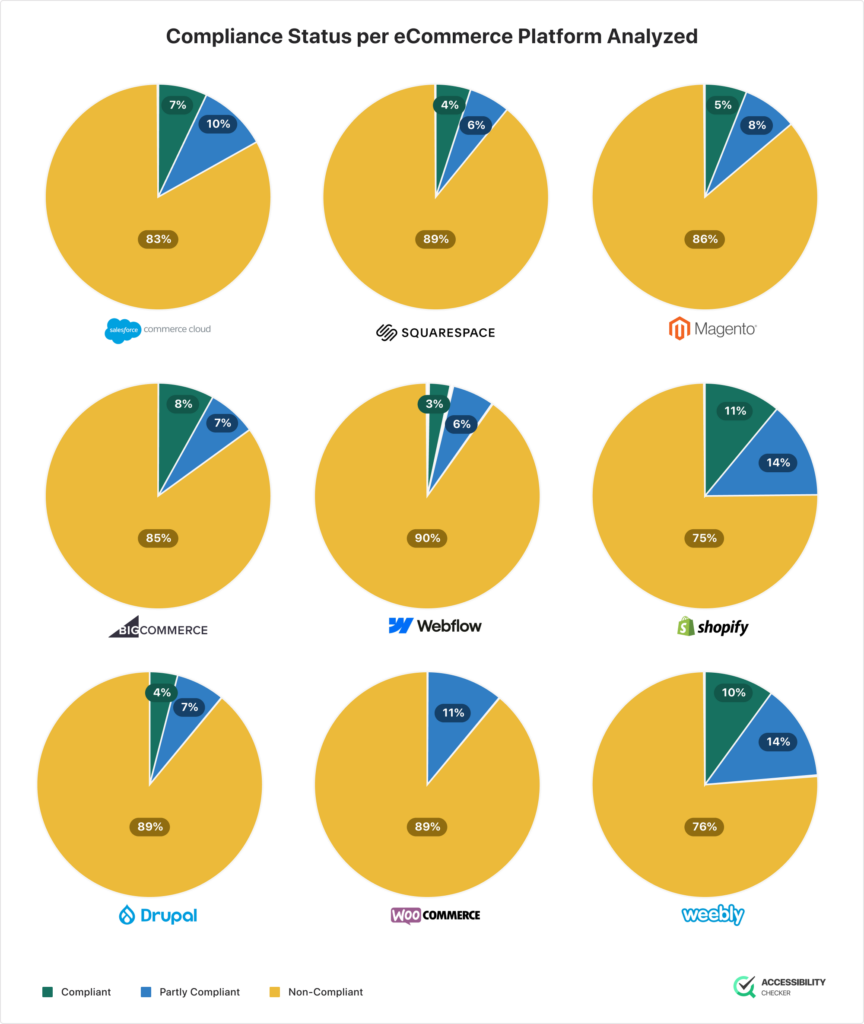
Like WordPress, platforms such as Shopify offer a variety of plugins that can make web accessibility compliance that much easier. While these plugins may not be able to get a site to full compliance, it can take them one step closer to a more user-friendly and inclusive website.
Awareness is key to creating real change, and eCommerce website owners need to do more in order to change the current average compliance scores.
What about Blogs and other CMS Websites?
Websites that are built on CMS platforms such as WordPress make web accessibility compliance easier thanks to plugins and other tools.
However, there are still a large number of websites that remain non-compliant or partly compliant, both of which leave them vulnerable to accessibility lawsuits.
| CMS Platform | Compliant Websites | Partly-Compliant Websites | Non-Compliant Websites |
| WordPress | 7% | 8% | 88% |
| Wix | 2% | 6% | 92% |
| Contentful | 3% | 0% | 97% |
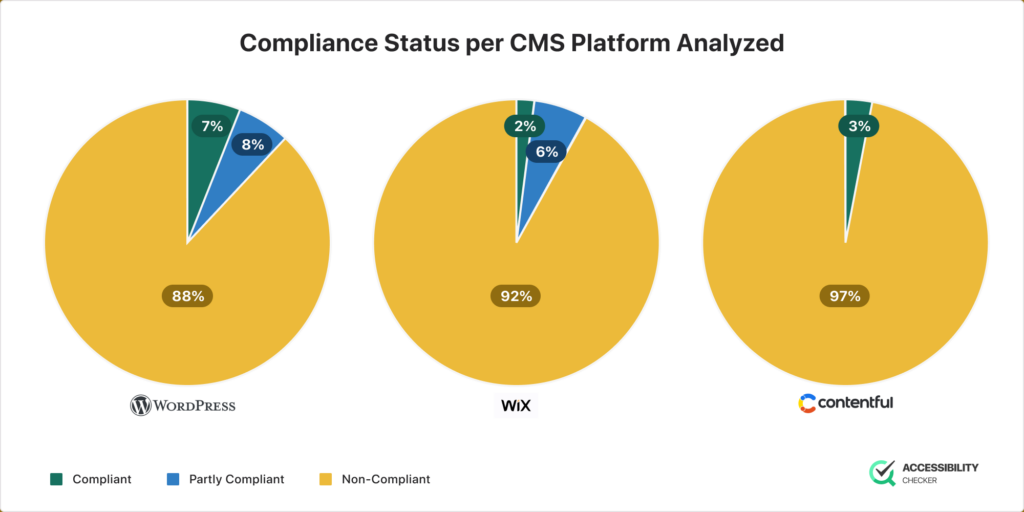
Website owners are encouraged to take advantage of the countless plugins and features offered by CMS platforms to get closer to full compliance.
Distribution of Compliance States Across Company Verticals
While there are compliant websites across multiple verticals, some sectors stand out from the rest.
Out of the websites we analyzed, we found that businesses in the Art and Entertainment, Business and Industrial, Education, Finance, and Technology sectors had the highest levels of non-compliance.
In the Business and Industrial sector, close to 20,000 of the websites that were analyzed were non-compliant. This was closely followed by websites in the Art and Entertainment sector with roughly 8,000 websites being non-compliant. Websites in the Technology sector showed similar stats.
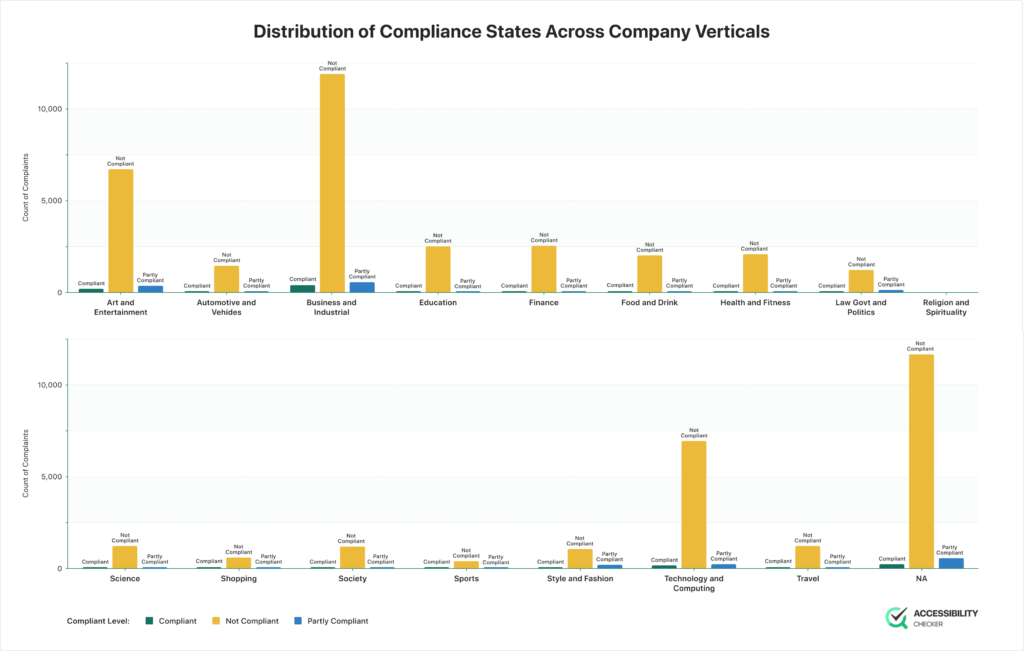
What’s concerning is that many of the businesses within these verticals are supplying essential everyday services to their customers, many of whom are living with some form of disability. Not only does this mean they are potentially creating barriers, but losing out on potential customers too.
In Closing
Even though web accessibility is a far more prominent topic than it once was, countless websites are still not fully compliant with the latest standards.
The cost of remaining non-compliant far outweighs the time, effort, and money it takes to remediate a website.
Regardless of industry, existing and new clients will interact with your website at one point or another and it only takes one person to initiate a lawsuit that can cause both financial and reputational damage.
Prioritizing accessibility now not only creates a more inclusive experience for all users, but safeguards your brand against lasting damage.




